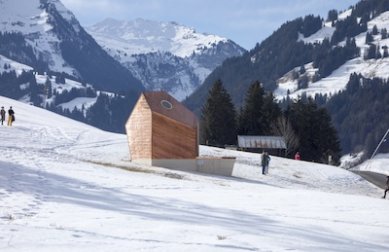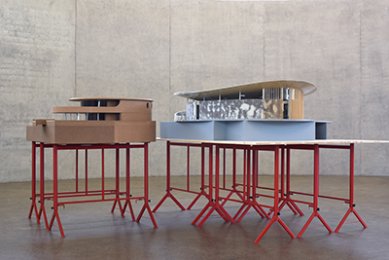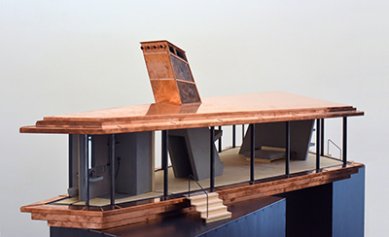
Thomas Schütte - exhibition at DUČB
Source
Michal Škoda, DUČB
Michal Škoda, DUČB
Publisher
Tisková zpráva
04.05.2022 13:00
Tisková zpráva
04.05.2022 13:00
Exhibitions
Czech Republic
České Budějovice
Thomas Schütte
Curator: Michal Škoda
It is a great honor for us to present Thomas Schütte with his first solo exhibition in the Czech Republic.
Schütte, who is considered by many to be one of the most important representatives of contemporary global sculpture alongside Antony Gormley and Anish Kapoor, focuses not only on sculpture but also intensively on drawing, with the central theme of his work being humanity and architecture. Contemplation of the human condition is always at the core of the artist's interest, regardless of the topic or materials used, with steel, bronze, ceramics, and glass being predominant. The most frequently addressed questions Schütte explores in his work are existential difficulties, cultural memory, the state of society with innumerable issues, as well as the image, moods, and efforts of humanity against the backdrop of life's turmoil.
Thomas Schütte was born in 1954 in Oldenburg, Germany. He studied at the Düsseldorf Academy of Arts under the guidance of Gerhard Richter and Fritz Schwegler. During the 1980s, he served as a visiting professor at the Hamburg University of Fine Arts. He has countless exhibitions at leading global institutions and galleries to his credit. In recent years, for example at the Stedelijk Museum in Amsterdam (2004), Haus der Kunst in Munich (2009), Museo Reina Sofía in Madrid (2010), Serpentine Gallery in London (2012), and Fondation Beyeler in Basel (2013), and in 2019 at Kunsthaus Bregenz and the Monnaie de Paris in Paris. This premiere in České Budějovice was preceded by exhibitions at the Kolbe Museum in Berlin and in London. In 2024, the Museum of Modern Art in New York plans a major retrospective of the artist's work. Schütte also participated in the Venice Biennale in 2005, where he received the Golden Lion, a highly prestigious award for exceptional work, and took part in Documenta exhibitions in Kassel in 1987, 1992, and 1997. He lives and works in Düsseldorf.
His work is represented in numerous public and private collections. Among them are the DIA Center for the Arts, New York City; Hirshhorn Museum and Sculpture Gardens, Washington DC; Centre Pompidou in Paris, France; MoMA, New York City; Tate Gallery, London, United Kingdom; and Walker Art Center, Minneapolis, Minnesota.
Thomas Schütte, known for his indefinability and highly individual approach to creation that does not succumb to fashion trends, still follows the advice he received from his teacher Gerhard Richter as a student—to find his own way by creating a repertoire, not a style. Schütte has often stated that this is not an easy path, but it is the right one for him. He rejected the idea of repeating a style to build a brand but often returns to previous themes, issues, and forms to further develop and transform them, exploring their meaning and scope.
It can be said that his work intertwines the history of sculpture with the present, as he continually seeks ways to update themes within today's issues through figure-based work, in light of the enormous interest in the now less frequently seen "classical" approaches to the study of the human body. With a frequently present humor and irony, he manages to critically comment on serious topics of human existence through distinctive typologies.
An integral part of Schütte's work is his interest in architecture, specifically the question of how to place architecture in direct relation to the concept of life. The roots of this interest go back to the 1980s when the author found inspiration and prompts in both construction culture and the theoretical discussion associated with the works of certain architects. Aldo Rossi had a significant influence on him, particularly when Schütte became acquainted with his Teatro del Mondo in Venice in 1980. It was a very impressive and contextually placed life-size model that, along with Rossi's theoretical research, which referred to “archetypes” as a crucial part of his expressive vocabulary, became an important reference for Schütte. The author draws from history and creates allegories of his worldview through architectural metaphors. The "model" becomes a fundamental aspect of his work, not only for the theme of architecture, but also a carrier of commentaries on contemporary society and the mechanisms through which society can function culturally and politically. For example, we encounter works where the museum serves as a crematorium, modernism is interpreted as a form of terrorism, or temples and houses for one person that can be both a refuge and a prison, alongside moments that in reality evoke little significance with their architecture, such as a parking garage or a gas station.
Some models have transformed into real buildings in recent years, thanks to the interest of private individuals who use them for living. In 2016, Schütte opened a building in Neuss, near Düsseldorf, constructed based on one of his models, serving as his own sculpture gallery, where he presents not only his works but also those of other artists. This building was expanded in April of this year with an additional object, creating a remarkable complex with a very sensitive integration into the local landscape that also provides spaces for an extensive archive of the artist's work.
This exhibition in České Budějovice can be said to be both an intimate and representative discourse on Schütte's work. The author is here presented alongside prints with three central themes: architectural Models, the theme of Heads, and a small selection from the extensive cycle “United Enemies.”
In the series “United Enemies,” Schütte drew inspiration from the ugly old men he saw during bus rides throughout his six-month stay in Rome, local art administrators who were feuding, or politicians inspired by news broadcasts about a corruption scandal, as “these deceitful faces” were constantly present in the media. This was primarily driven by his interest in the portrait as a subject, so typical for this place that has been linked to the culture of portrait sculpture for centuries.
In the theme of Heads, on one hand, it involves a deliberate subversion of the dignified form of the bust, as in the works from the cycle Old Friends, where the men do not appear as significant personalities, but rather as resigned figures. The author emphasizes expression, various typologies, and physiognomy, reflecting his interest in a certain grotesque exaggeration. In his female heads, he remains true to the approach of not creating actual portraits, but rather schematics and archetypes that serve as open projection surfaces, offering the viewer an opportunity for individual reflection and introspection.
Through the selection from the cycle of Architectural Models, Schütte presents his imaginary world, indicating a personal contemplation of the position of mankind and how architecture can shape space and influence society.
It is a great honor for us to present Thomas Schütte with his first solo exhibition in the Czech Republic.
Schütte, who is considered by many to be one of the most important representatives of contemporary global sculpture alongside Antony Gormley and Anish Kapoor, focuses not only on sculpture but also intensively on drawing, with the central theme of his work being humanity and architecture. Contemplation of the human condition is always at the core of the artist's interest, regardless of the topic or materials used, with steel, bronze, ceramics, and glass being predominant. The most frequently addressed questions Schütte explores in his work are existential difficulties, cultural memory, the state of society with innumerable issues, as well as the image, moods, and efforts of humanity against the backdrop of life's turmoil.
Thomas Schütte was born in 1954 in Oldenburg, Germany. He studied at the Düsseldorf Academy of Arts under the guidance of Gerhard Richter and Fritz Schwegler. During the 1980s, he served as a visiting professor at the Hamburg University of Fine Arts. He has countless exhibitions at leading global institutions and galleries to his credit. In recent years, for example at the Stedelijk Museum in Amsterdam (2004), Haus der Kunst in Munich (2009), Museo Reina Sofía in Madrid (2010), Serpentine Gallery in London (2012), and Fondation Beyeler in Basel (2013), and in 2019 at Kunsthaus Bregenz and the Monnaie de Paris in Paris. This premiere in České Budějovice was preceded by exhibitions at the Kolbe Museum in Berlin and in London. In 2024, the Museum of Modern Art in New York plans a major retrospective of the artist's work. Schütte also participated in the Venice Biennale in 2005, where he received the Golden Lion, a highly prestigious award for exceptional work, and took part in Documenta exhibitions in Kassel in 1987, 1992, and 1997. He lives and works in Düsseldorf.
His work is represented in numerous public and private collections. Among them are the DIA Center for the Arts, New York City; Hirshhorn Museum and Sculpture Gardens, Washington DC; Centre Pompidou in Paris, France; MoMA, New York City; Tate Gallery, London, United Kingdom; and Walker Art Center, Minneapolis, Minnesota.
Thomas Schütte, known for his indefinability and highly individual approach to creation that does not succumb to fashion trends, still follows the advice he received from his teacher Gerhard Richter as a student—to find his own way by creating a repertoire, not a style. Schütte has often stated that this is not an easy path, but it is the right one for him. He rejected the idea of repeating a style to build a brand but often returns to previous themes, issues, and forms to further develop and transform them, exploring their meaning and scope.
It can be said that his work intertwines the history of sculpture with the present, as he continually seeks ways to update themes within today's issues through figure-based work, in light of the enormous interest in the now less frequently seen "classical" approaches to the study of the human body. With a frequently present humor and irony, he manages to critically comment on serious topics of human existence through distinctive typologies.
An integral part of Schütte's work is his interest in architecture, specifically the question of how to place architecture in direct relation to the concept of life. The roots of this interest go back to the 1980s when the author found inspiration and prompts in both construction culture and the theoretical discussion associated with the works of certain architects. Aldo Rossi had a significant influence on him, particularly when Schütte became acquainted with his Teatro del Mondo in Venice in 1980. It was a very impressive and contextually placed life-size model that, along with Rossi's theoretical research, which referred to “archetypes” as a crucial part of his expressive vocabulary, became an important reference for Schütte. The author draws from history and creates allegories of his worldview through architectural metaphors. The "model" becomes a fundamental aspect of his work, not only for the theme of architecture, but also a carrier of commentaries on contemporary society and the mechanisms through which society can function culturally and politically. For example, we encounter works where the museum serves as a crematorium, modernism is interpreted as a form of terrorism, or temples and houses for one person that can be both a refuge and a prison, alongside moments that in reality evoke little significance with their architecture, such as a parking garage or a gas station.
Some models have transformed into real buildings in recent years, thanks to the interest of private individuals who use them for living. In 2016, Schütte opened a building in Neuss, near Düsseldorf, constructed based on one of his models, serving as his own sculpture gallery, where he presents not only his works but also those of other artists. This building was expanded in April of this year with an additional object, creating a remarkable complex with a very sensitive integration into the local landscape that also provides spaces for an extensive archive of the artist's work.
This exhibition in České Budějovice can be said to be both an intimate and representative discourse on Schütte's work. The author is here presented alongside prints with three central themes: architectural Models, the theme of Heads, and a small selection from the extensive cycle “United Enemies.”
In the series “United Enemies,” Schütte drew inspiration from the ugly old men he saw during bus rides throughout his six-month stay in Rome, local art administrators who were feuding, or politicians inspired by news broadcasts about a corruption scandal, as “these deceitful faces” were constantly present in the media. This was primarily driven by his interest in the portrait as a subject, so typical for this place that has been linked to the culture of portrait sculpture for centuries.
In the theme of Heads, on one hand, it involves a deliberate subversion of the dignified form of the bust, as in the works from the cycle Old Friends, where the men do not appear as significant personalities, but rather as resigned figures. The author emphasizes expression, various typologies, and physiognomy, reflecting his interest in a certain grotesque exaggeration. In his female heads, he remains true to the approach of not creating actual portraits, but rather schematics and archetypes that serve as open projection surfaces, offering the viewer an opportunity for individual reflection and introspection.
Through the selection from the cycle of Architectural Models, Schütte presents his imaginary world, indicating a personal contemplation of the position of mankind and how architecture can shape space and influence society.
The English translation is powered by AI tool. Switch to Czech to view the original text source.





0 comments
add comment






